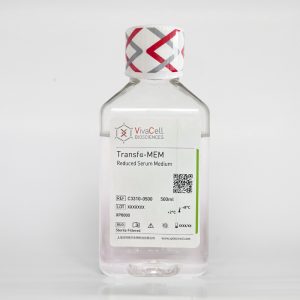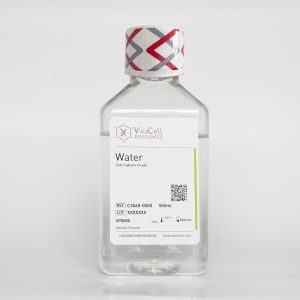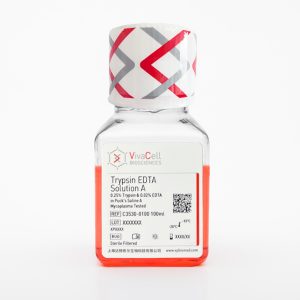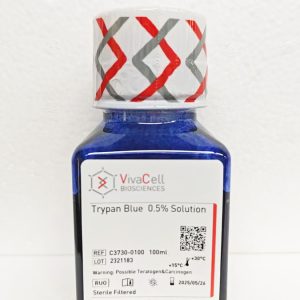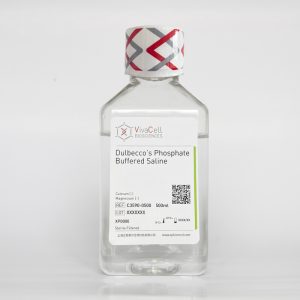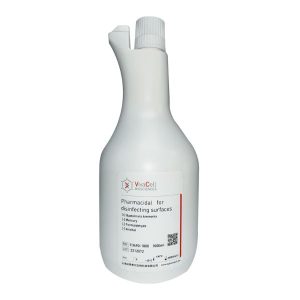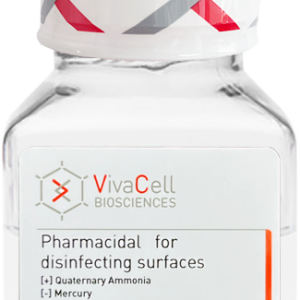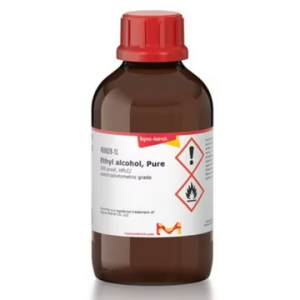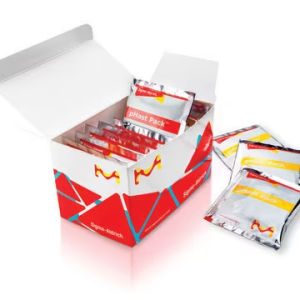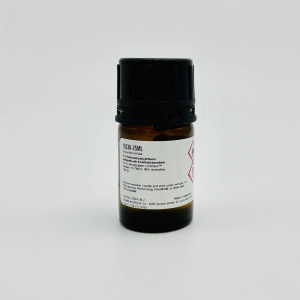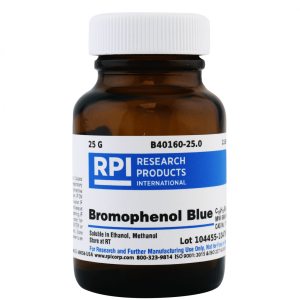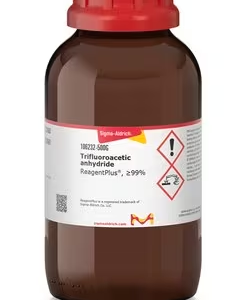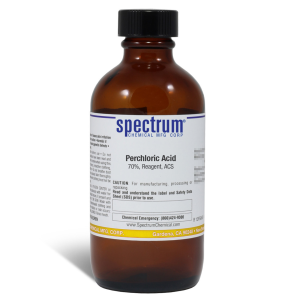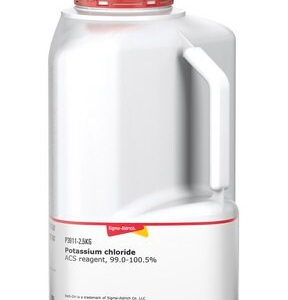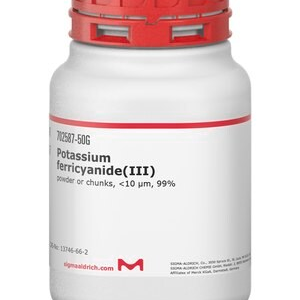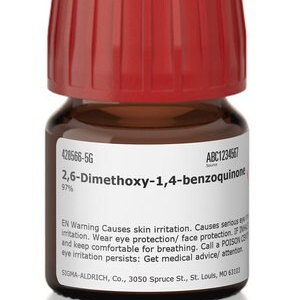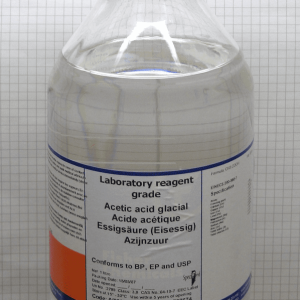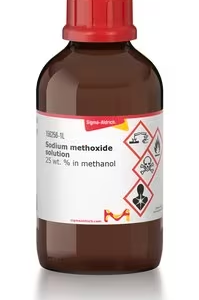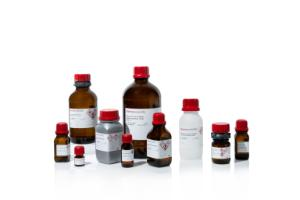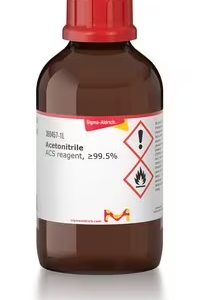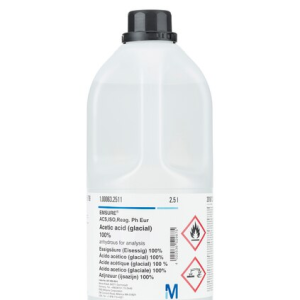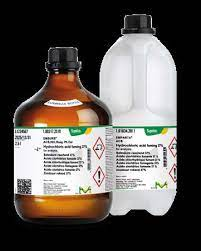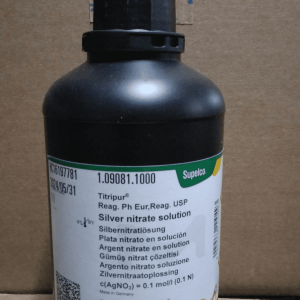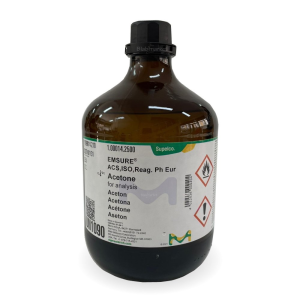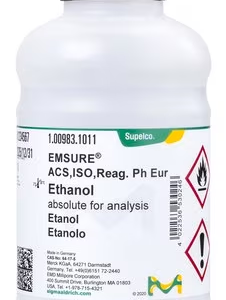-
C3310-0500, TransfMEM
TransfMEM-α Reduced Serum Medium. Pkg size: 500 ml/bottle
-
C3560-0500, Water, Cell Culture
Water, Cell Culture Grade
-
C3530-0100, Trypsin-EDTA solution A
Trypsin EDTA Solution A (0.25%), EDTA (0.02%), with Phenol Red
-
C3730-0100, Trypan Blue
Trypan Blue Solution, 5mg/ml in Saline
-
C3590-0500, dPBS, without Ca and Mg
Vivacell dPBS, without Ca and Mg, 500 ml/bottle <Amb Storage>
-
C3490-1000, Anti-mycoplasma, fungal, virus and bacterial spray (1L)
Pharmacidal, for disinfecting surfaces. Pkg size: 1 litre/bottle
-
C3490-0100, Anti-mycoplasma, fungal, virus and bacterial spray (100ml)
Pharmacidal, for disinfecting surfaces. Pkg size: 100 ml/bottle
-
ETHYL ALCOHOL, PURE 200 PROOF, ACS REAGENT, 99.5% (459844-1L) (PCS)
Ethyl alcohol, Pure 200 proof, HPLC/spectrophotometric grade
-
SULFURIC ACID CONCENTRATE (0.2N) (68279-1L)
This solution contains sulfuric acid with a normality of 0.2 N, indicating that it has the equivalent of 0.2 moles of H2SO4 per liter of the solution. Sulfuric acid is a strong and highly corrosive acid often used in various chemical, industrial, and laboratory applications. The 0.2 N concentration is specifically prepared for applications requiring this particular normality, such as in acid-base titrations or pH adjustments.
-
TRIS BUFFER (PPB023-20PAK)
Tris buffer, or tris(hydroxymethyl)aminomethane, is a commonly used chemical compound for preparing buffer solutions in biochemical and molecular biology applications. It is known for its ability to maintain a stable pH in various experimental conditions and is widely used to control and maintain pH in laboratory procedures, such as electrophoresis and enzymatic reactions.
-
HYDROCHLORIC ACID ACS REAGENT, 37% (258148-500ML)
This is a high-purity grade of hydrochloric acid with a concentration of 37%. It is designed for use in analytical and laboratory applications, adhering to the quality standards established by the American Chemical Society (ACS). Hydrochloric acid is a strong and highly corrosive acid used in various chemical and analytical procedures.
-
N,O-BIS (TRIMETHYLSILYL) TRIFLUOROACETAMI (15238-10X1ML) (SET)
BSTFA is a chemical reagent used in analytical and laboratory settings. It is commonly employed for derivatization, a process that modifies compounds to make them more suitable for analysis, especially in gas chromatography-mass spectrometry (GC-MS) applications. BSTFA helps convert certain compounds into more volatile forms for better detection and analysis.
-
BROMOPHENOL BLUE (B0126-25G)
Bromophenol blue is a pH indicator dye used in various laboratory and industrial applications. It can change color depending on the pH of the solution, typically transitioning from yellow (acidic) to blue (basic).
-
METHYL MYRISTATE (M3378-25G)
Methyl myristate is an ester compound with the chemical formula C15H30O2. It is used in a variety of applications, including the cosmetic and pharmaceutical industries, where it can serve as a fragrance ingredient, emollient, and as a base for various products.
-
BUFFER, REFERENCE STANDARD PH 4.00,0.01 (25C) (B5020-6X500ML)
This is a specialized buffer solution prepared to have a precise pH value of 4.00 with a high level of accuracy, typically within a range of ±0.01 pH units. These reference standard buffer solutions are used in laboratory and analytical settings to calibrate and verify the accuracy of pH meters and electrodes.
-
TRIFLUOROACETIC ANHYDRIDE (106232-100G) (SET)
Trifluoroacetic anhydride is a chemical compound with the formula (CF3CO)2O. It is employed in various chemical and laboratory applications, primarily as an acylating reagent for the introduction of acyl groups into organic compounds. Trifluoroacetic anhydride is known for its acylating properties and is used in synthetic chemistry and research.
-
TUNGSTEN OXIDE (WO3-X) NANOPARTICLE INK (793353-25ML)
This is an ink or solution that contains tungsten oxide nanoparticles (denoted as WO3-X), typically used in the manufacturing of electronic and optical devices. These nanoparticles can be used in various applications, such as sensors, displays, and energy devices, where their unique properties are advantageous. The “X” in the formula indicates that the exact composition may vary, depending on the specific properties desired for the ink.
-
PERCHLORIC ACID, 70%, A.C.S. REAGENT (244252-1L)
This is a high-purity grade of perchloric acid with a concentration of 70%. It is designed for use in analytical and laboratory applications, adhering to the quality standards established by the American Chemical Society (ACS). Perchloric acid, known for its strong oxidizing properties, is used in various chemical and analytical procedures.
-
POTASSIUM CHLORIDE ACS REAGENT, 99.0-100.5% (P3911-500G)
This is a high-purity grade of potassium chloride intended for analytical and laboratory applications. It adheres to the quality standards outlined by the American Chemical Society (ACS). The percentage range, 99.0-100.5%, indicates its purity, ensuring reliable and precise results in analytical procedures.
-
DUROQUINONE (D223204-1G)
Duroquinone, with the chemical formula C16H12O4, is a compound derived from anthraquinone. It is used in various chemical and industrial applications, including as a reagent in chemical processes and as a component in the production of dyes and other chemicals
-
METHYL MYRISTATE (W272205-8KG)
Methyl myristate is an ester compound with the chemical formula C15H30O2. It is used in a variety of applications, including the cosmetic and pharmaceutical industries, where it can serve as a fragrance ingredient, emollient, and as a base for various products.
-
ERIOCHROME BLACK T (858390-100G) (SET)
Eriochrome Black T is a complexometric indicator commonly employed in analytical chemistry for the determination of metal ions, such as calcium and magnesium, through titration. It is known for its color changes in the presence of metal ions, making it a valuable tool in various titration procedures.
-
2,2,2-TRIFLUOROETHANOL (T63002-100G) (SET)
2,2,2-Trifluoroethanol is a colorless and flammable liquid with the chemical formula CF3CH2OH. It is used in various chemical and industrial applications, including as a solvent, reagent, and in organic synthesis. This compound has specific properties and uses that may vary depending on the application or process in which it is employed.
-
POTASSIUM DICHROMATE (207802-100G)
Potassium dichromate is a bright orange, crystalline solid with the chemical formula K2Cr2O7. It is widely used in various chemical and industrial applications, including as an oxidizing agent, in analytical chemistry, and in the production of various chemicals.
-
POTASSIUM FERRICYANIDE (III) (702587-50G)
Potassium ferricyanide (III) is a red crystalline solid with the chemical formula K3[Fe(CN)6]. It is used in various chemical and laboratory applications, including as a reagent in chemical reactions and as a dye in some applications. Potassium ferricyanide (III) has specific properties and uses that may vary depending on the application or process it is involved in.
-
TETRAFLUORO-1,4-BENZOQUINONE (104353-1G)
Tetrafluoro-1,4-benzoquinone is a chemical compound known for its quinone structure and the presence of four fluorine atoms. It is used in various industrial and chemical applications, often as a reagent in organic synthesis and chemical processes.
-
POTASSIUM CHLORIDE (P3911-25G)
Potassium chloride is a white crystalline salt commonly used for various purposes, including as a fertilizer, a nutritional supplement, and in various industrial and medical applications. In the medical field, it is sometimes used for intravenous treatments and in the production of saline solutions.
-
ACETIC ACID (27225-500ML-R)
Acetic acid is a colorless liquid with a pungent odor. It is a weak organic acid and a crucial chemical in various applications, including as a solvent, preservative, and in the production of numerous chemicals and materials. It is also known as the primary component of vinegar.
-
SODIUM METHOXIDE, 25 WT. % SOLUTION (156256-1L)
This is a chemical solution containing sodium methoxide (NaOCH3) dissolved in a solvent, with a concentration of 25% by weight. Sodium methoxide is a strong base and is often used in organic synthesis and various chemical reactions. The 25% solution provides a convenient way to handle and use sodium methoxide in applications that require a specific concentration.
-
METHYL DOCOSANOATE (11940-5G) (SET)
Methyl docosanoate is an ester, specifically the methyl ester of docosanoic acid. It is often used in various industrial and chemical applications, including as a component in the production of perfumes, flavors, and cosmetics. This compound can have a waxy or oily consistency and may serve as a fragrance fixative or emollient in personal care products and fragrances.
-
N-HEPTANE GR (1.04379.1000) (1L)
This is n-heptane, a straight-chain alkane hydrocarbon, typically with a specific grade designation. N-heptane is a colorless and flammable organic solvent commonly used in chemical and industrial applications, as well as in laboratories for various purposes. The “GR” designation may indicate that it meets certain quality or purity standards.
-
ACETONITRILE (1.00030.2500) (2.5L)
Acetonitrile is a colorless and flammable organic solvent widely used in applications such as chemical synthesis, chromatography, and as a reaction medium in various laboratory and industrial processes. It is known for its relatively high polarity and ability to dissolve a wide range of substances.
-
BUFFER SOLUTION PH7 (1.09407.1000) (1L)
A “buffer solution pH 7” is a chemical solution that is prepared to have a specific pH of 7. Buffer solutions are designed to resist significant changes in their pH when acids or bases are added to them. A buffer solution with a pH of 7 is considered neutral because it has an equal concentration of hydrogen ions (H+) and hydroxide ions (OH-) and is often used as a reference point in various laboratory and analytical applications. The pH of 7 is the midpoint on the pH scale, with values below 7 being acidic and values above 7 being alkaline or basic.
-
ACETIC ACID (GLACIAL) 100% (1.00063.2500) (2.5L)
This is glacial acetic acid, a highly concentrated and pure form of acetic acid with a concentration of 100%. It is a colorless liquid with a pungent odor and is used in various chemical, industrial, and laboratory applications. Glacial acetic acid is employed as a solvent, reagent, and in chemical processes.
-
WATER GR FOR ANALYSIS (1.16754.4000) (4L)
This is water that conforms to defined purity standards suitable for analytical and laboratory applications. The “GR” designation likely indicates that it meets certain quality criteria. It is used as a solvent and reagent in various chemical and analytical procedures, ensuring that impurities do not interfere with the results.
-
SILVER NITRATE SOLUTION (1.09081.1000) (1L)
Silver nitrate solution is an aqueous solution of silver nitrate (AgNO3), a compound known for its reactivity with halides and other substances. It is used in a wide range of applications, including as a reagent in chemical reactions, as a stain in biological and medical procedures, and in analytical chemistry.
-
SULFURIC ACID 2 N (1.60313.1000) (1L)
This solution contains sulfuric acid with a normality of 2 N, indicating that it has the equivalent of 2 moles of H2SO4 per liter of the solution. Sulfuric acid is widely used in various chemical and industrial applications, including as a strong acid for pH adjustments and in chemical reactions.
-
ACETONE (GR) (1.00014.2500) (2.5L)
This is acetone, a colorless and flammable organic solvent, typically with a specific grade designation. Acetone is used in various industrial, laboratory, and household applications, including as a solvent, cleaning agent, and in chemical processes. The “GR” may indicate that it meets certain quality standards or specifications.
-
ETHANOL ABSOLUTE GR (1.00983.2511) (2.5L)
This is absolute ethanol, a highly pure form of ethanol (ethyl alcohol) often used in laboratory and industrial applications. The “GR” likely indicates that it meets certain quality standards or specifications. Absolute ethanol is almost entirely free of water, making it ideal for various chemical processes, including as a solvent, reagent, and in analytical applications.
-
SODIUM HYDROXIDE 5 N (1.09913.0001) (SET)
This solution contains sodium hydroxide with a normality of 5 N, indicating that it has the equivalent of 5 moles of NaOH per liter of the solution. Sodium hydroxide is a strong and highly caustic base used in various industrial, laboratory, and chemical applications. It is employed for tasks such as pH adjustments, chemical reactions, and titrations








